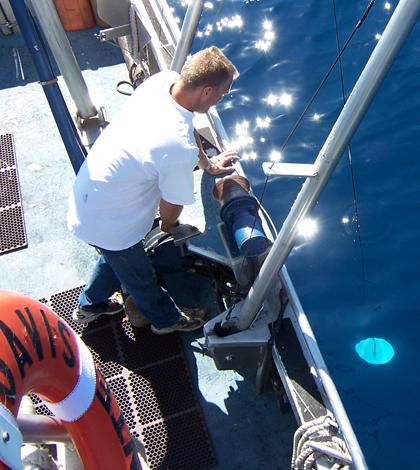Long-term Secchi disk records show Lake Tahoe clarity decline has stabilized

Tahoe Environmental Research Center boat captain Brant Allen conducting a Secchi depth measurement (Credit: Geoff Schladow)
Lake Tahoe is one of the clearest lakes in the United States, helped by the relatively small size of its surrounding watershed and the granitic basin it sits in.
Around 1968, the first year that its clarity was measured by Secchi disk, Tahoe’s blue waters were even clearer than they are today. Measurements at that time show an average yearly clarity of more than 100 feet. But such clarity was never reported again as its waters began a decline that lasted well into the 1990s.
At that point, the decline of average annual clarity measurements leveled out and stabilized, which is better news than it sounds. According to measurements taken by scientists at University of California, Davis, the trend of stable clarity for Lake Tahoe is continuing, and they report a 2013 average clarity of 70.1 feet.
“There are very few lakes that have clarity like Lake Tahoe,” said Geoff Schladow, director of the Tahoe Environmental Research Center at UC Davis. “The only one that comes to mind is Crater Lake, but that one’s in a national park.”
Lake Tahoe’s surroundings are different, and unlike the untouched clearness of Crater Lake, Tahoe’s water is affected by erosion from urban areas. Its surrounding basin is impervious granite, so runoff that is typically absorbed by soil around other lakes makes its way into Lake Tahoe.
But Schladow says the problem of erosion is a bigger concern for clarity than runoff. Airborne inorganic particles like clay and silt, often flung up by cars, make their way in and make the water murkier. Small phytoplankton also contribute to minimized clarity.
The water’s cloudiness is measured by Secchi disk measurements, but is also tracked by PAR sensors that measure light attenuation. Schladow and others also measure light’s backscatter through Tahoe’s wake.

NASA and UC Davis also operate a research buoy on Lake Tahoe (Credit: Geoff Schladow)
But the No. 1 way to measure clarity is still with a Secchi disk. This is because taking the measurement is simple, and also because clarity measurements with Secchi disks comprise the longest continual measurement that scientists have for Lake Tahoe.
“From 1968 to about 2000, it’s a pretty much straight-line decrease. But since 2000, clarity has more or less stabilized around the same levels,” said Schladow. “It’s neither getting worse or better, but the fact that it’s not getting worse is a huge achievement.”
Schladow says Secchi disk measurements are taken in two locations that usually yield similar readings. Clarity is a little lower in the summer, but that’s expected as there’s more dust in the air and more recreation on the water. In the winter months, clarity ticks up.
This same dependability on weather has been shown with ongoing drought conditions in California. Less rain has meant less runoff gets into Lake Tahoe, so clarity for the period has gone up.
But given long-term plans, Schladow says higher water levels expected when drought conditions subside won’t automatically mean less clarity for Lake Tahoe.
“Restoration efforts here are targeted at reducing fine particle and nutrient levels, regardless of weather conditions,” said Schladow. “In time, we hope we can have a wet year with low impact on water clarity.”
Top image: Tahoe Environmental Research Center boat captain Brant Allen conducting a Secchi depth measurement (Credit: Geoff Schladow)





Pingback: Friday Five: Some of the World's Clearest Lakes - Lake Scientist
Pingback: Study to Focus on Lake Tahoe's Threatened Nearshore Waters - Lake Scientist
Pingback: Lake Tahoe Sees Mysterious Loss Of Aquatic Animals And Vegetation - Lake Scientist
ken
December 25, 2015 at 1:51 pm
In 1957 a friend and I were canoeing in the lake and spotted a glittering yellow mass on the sandy bottom some 5-6 feet below us. My friend wanted a sample of this ‘gold’ and I gladly dove in to retrieve some of this treasure knowing I could easily reach it. My effort provided futile and discouraging until we dropped a weighted string into the water to see how deep it was. The string was about 20 feet long (based on 4 stretches of my arms) and did not reach the bottom. The littoral zone clarity was incredible.
Pingback: Lake Tahoe Clarity Down In 2015 - Lake Scientist